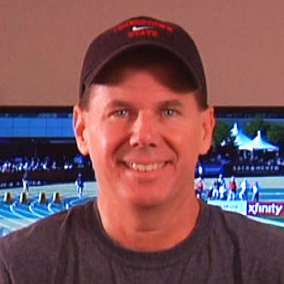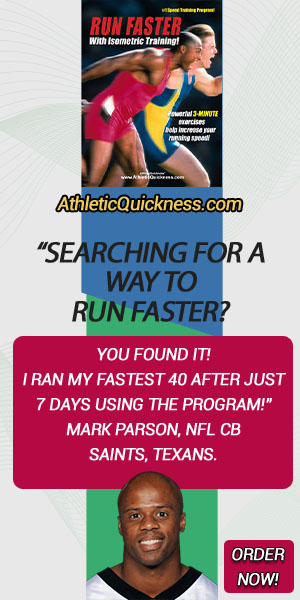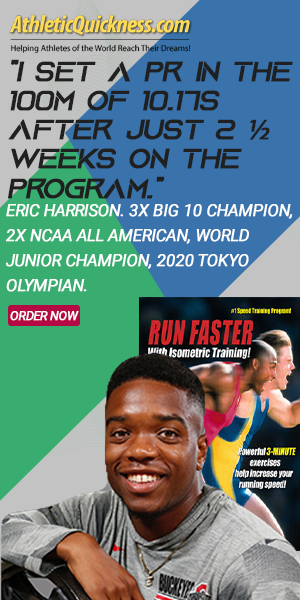Faster running starts begin with strong hip extensor muscles, mainly your glutes and hamstrings. They help power the running motion with a strong pushing force caused when the thigh is extended behind the hip. The knee extends and the ankle plantar-flexes. It is a pushing motion because the force created by the leg on the ground causes motion to take place away from it.

The running motion
There are three distinct phases to the running motion.
1) the Push Phase,
2) the Swing Phase and
3) the Pull Phase.
Each leg will cycle repeatedly through these three phases, over and over again, while you run. For example, the right leg will cycle as follows:
Push phase >> Swing Phase >> Pull Phase >> Push Phase >> Swing Phase……
The left leg follows a similar pattern although it is not in synch with the right leg with respect to the phase that is in.
To help us identify which phase of running a given leg is in, we need to establish a point of reference. Therefore, the main point of reference for the running motion will be the thigh’s position in relation to the ground. The thigh is that part of the leg between the hip and the knee. With this in mind let’s talk about these three phases of running for the right leg in more detail.
The Push Phase
Everyone’s “favorite”, the Push Phase, or power phase to some, is one of two phases (the other being the Pull Phase) where the entire phase takes place while the foot is in contact with the ground. The beginning of this phase starts when the thigh of the foot that is touching the ground is found to be perpendicular to it and it ends when the toes of this same foot make their last contact with the ground behind the runner.
Looking at Figure 1-1a below, we can see that the runner’s right thigh is perpendicular to the ground and therefore this signals the start of the Push Phase for the right leg. As the running motion advances as seen in Figure 1-1b, we still see the right foot in contact with the ground but we also start to notice the right thigh (hip) extending behind him, i.e., the thigh is no longer perpendicular to the ground.
And finally, Figure 1-1c shows the thigh (hip) completely extended behind the runner and also what looks to be like the last remaining contact the toes have with the ground. This would signal the end of the Push Phase.

Pushing Forces
The reason why this phase is called the Push Phase is because it involves a pushing-type force with the leg. Pushing forces are forces that cause motion away from the source of the force.
The source of the force here are the muscles in the back of the leg acting on the hip, knee and ankle joints which force the entire leg backward, behind the runner, as seen previously in Figure 1-1c.
Through powerful contractions, the hip extensor muscles, knee (or leg) extensor muscles and the ankle plantar-flexor muscles displace, or move, the rest of the runner’s body forward, away from the force created by the leg (i.e.. the source), in a pushing-type manner.
Specifically, the hip extensor muscles are the Gluteus Maximus and the hamstrings, namely, the Biceps Femoris (long head), Semimembranosus and Semitendinosus.
The knee extensors, also known as the Quadriceps, are the Rectus Femoris, Vastus Medialis, Vastus Lateralis and Vastus Intermedius.
And the Ankle Plantar-flexors, or the calf muscles, are the Gastrocnemius and Soleus.
Now the push phase is an extremely important part of the running process and certainly requires the proper amount of training however, you absolutely must recognize one important fact if you are ever going to start taking the right steps to become a faster athlete: the Push Phase accounts for only 1/3 of the total running motion yet most of one’s training, and perhaps even yours, focuses almost 100% on exercises designed to try and improve this phase of running only.
If this is true, could this at least be one reason why you do not see any improvement with your running speed in spite of all the hours of training you put in?
Common Push Phase Exercises
To give you an example of what I mean, let’s take a look at some of the more common exercises you might find yourself doing in the gym to help increase your running speed: power cleans, lateral squats, front squats, single leg Romanian Dead Lifts (RDL’s), Glute-ham raises, Back Squats, clean/pull, eccentric hamstrings exercises, leg extensions and box jumps.
Most, if not all of these exercises, involve either your hip extensors and/or knee extensors. That’s it. And as you already have learned previously, these two muscle groups dominate the Push Phase of running. But as you are going to see here in a minute, running is a whole lot more than just pushing with the hips and knees.
And if you aren’t properly balancing your training over all of the muscles used in it (both pushing and pulling muscles) then you will be creating huge deficiencies not only in your strength to run, but also in your speed and form.
Now before we go on to the next phase or running I want to mention one of the main reasons I believe that most athletes never get to train beyond the Push Phase, or Power Phase, of running.
First, this has to deal with the fact that most gym equipment for your legs is designed to train muscles involved with the Push Phase of running only and they are not really set up to target any of the muscles involved in the other two phases; the Swing Phase and the Pull Phase.
So as soon as you walk in to a gym you are unwittingly at an immediate disadvantage if all you do is work on the machines that are already laid out there before you and you don’t do much of anything else. This doesn’t mean you shouldn’t use them, it simply means that you are going to need to be a lot more creative in your workouts if you ever expect to have a major breakout with your sprint times.
Olympic Lifts
Second, even some of the free weight exercises like the growing popularity of the Olympic lifts such as the power clean and the clean-pull, only target the muscles in the Push Phase with respect to the legs.
Athletes are gravitating towards these exercises with the hopes of having a breakthrough in their running speed and while they are highly recommended, they still will only target the hip extensors and knee extensors with respect to the legs.
This is because they are a squat-type exercise where hips and knees are initially flexed, and as a result, all of the strain is placed on the buttocks (glutes and hamstrings) and knees (quadriceps). So while it’s a good idea to do them, you shouldn’t expect any real change in your running speed if you are already actively involved in some of the previous exercises that were just mentioned.
Plus, these exercises don’t train the hip extensors and knee extensors in the same planes of motion as they are needed for running, which is primarily the horizontal plane such as down a field or track, and only a slightly in the vertical plane. Instead, they train these muscle groups specifically in the vertical plane only.
This is why you will have many football players showing incredible vertical jumping ability where standing verticals get up near the 38” and 39” marks fairly regularly, even for the larger-sized athletes. But this vertical jumping ability doesn’t always carry over very well into the running speed department for these same athletes because again, the muscles aren’t being trained specifically enough for that.
So if this sounds familiar to you, keep on reading as you are about to discover there is a whole lot more that you can do to help yourself get faster.



